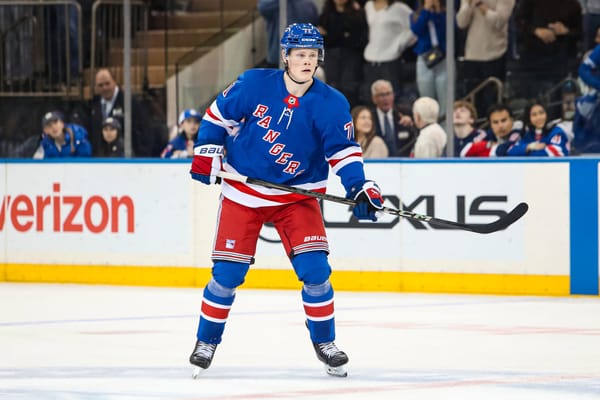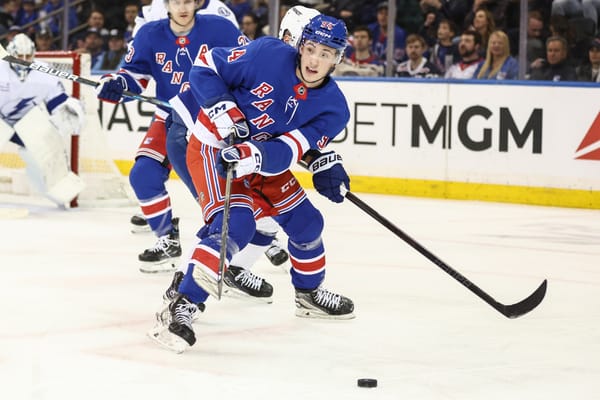2020 NHL Draft: The Main Contenders for the Rangers at 22nd Overall
Alexis Lafreniere is the main act, but there are many intriguing prospects the Rangers could grab with their other first-round pick.
There are zero doubts about what the Rangers will do with the first-overall pick — Alexis Lafreniere will go to bed Tuesday night as a member of the New York Rangers. Thus, all suspense for the Rangers is focused on what the Rangers will do with the 22nd-overall pick, acquired from Carolina at the trading deadline in return for Brady Skjei.
Predicting what the Rangers will do is extremely hard. They are partially beholden to what the teams picking before them and there are many players who could be available at that spot and make sense. Of course, General Manager Jeff Gorton could just as well trade up, trade down, or trade the pick for an active NHLer.
But as classical philosopher Paris Hilton once wrote, “I think it’s important to be confident. Believe in yourself and everybody’s hot.”
I’m going to heed her advice. Through some combination of whispers Blueshirt Banter has heard, my own identification of intriguing prospects, and gut feeling, here are my seven-best guesses (in no particular order) at whom the Rangers, assuming they keep the pick, might select.
Rodion Amirov, Left Wing, Salavat Yulaev Ufa (KHL)
The Russian winger is an electric two-way presence. On the puck, Amirov displays a shiftiness that makes him elusive. He can quickly change directions and veils his intention with his body language before suddenly pivoting a different direction. He’s a dynamo carrying the puck past individuals clogging up the neutral zone. In the offensive zone, his agility lends carrying the puck from the perimeter and slipping into more dangerous positions across the slot line.
He has the potential to be a creative playmaker. One of his favorite moves is passing the puck off the boards in-stride. Sometimes the pass is to a teammate in transition with him. Often times, it’s to himself. He displays plenty of creativity and prescience. Yet his assist numbers at various levels don’t reflect that. Why not? As EP Rinkside’s Mitch Brown pointed out, Amirov is overly reliantly on beating players one-on-one rather than using teammates within a functioning five-man offensive unit.
One might surmise that he’s been by far the best player on his teams at lower levels and has gotten used to being self-reliant in generating offense. That won’t work against better, organized teams.
In the defensive zone, he shows a lot of effort and intuition. He’s probably not a penalty killer at the NHL level, but he has a pretty good understanding of when to aggressively pressure the puck versus when to lay off and cut off lanes of importance.
TSN’s Bob McKenzie, who bases his draft rankings on NHL scout consensus, had Amirov ranked 19th. However, that list was published in late June. The 2020-21 KHL season has since begun and Amirov has been one of the early storylines, registering three goals and two assists through 10 games for Salavat Yulaev Ufa.
I spoke to one NHL scout, without mentioning Amirov, asking if he thought these early games in certain leagues would alter draft boards across the NHL in the weeks prior.
“I think most are locked in barring extremes. Like Lucas Raymond (in Sweden) might look good now but that’s saying guys in NA also haven’t improved during the time off,” he said.
Still, he’s just one scout for one team, and I imagine it’s difficult to ignore these games altogether. Amirov is firmly in the mix for 22nd overall for the Rangers, but it’s fair to wonder if his stock has risen at least a little bit these last few weeks.
I believe Amirov is a player the Rangers would be interested in. If he is untaken in the teens, a reason why could be that teams are afraid to invest in a Russian prospect who will need a lot of hands-on development. Amirov could potentially spend a number of years in the KHL before coming over to North America, and the city of UFA is fairly east. Suffice to say that it will be easier for some teams with smaller staffs and budgets to monitor and instruct a player in, let’s say, Stockholm or Ontario.
Hendrix Lapierre, Center, Chicoutimi Saguenéens (QMJHL)
Lapierre happens to be the player we took at 22nd overall in the SB Nation 2020 Mock Draft.
The Quebecois center was a top prospect entering this draft year He had a strong 2018-2019 performance in the QMJHL and was one of the top players at the U18 Hlinka Gretzky Tournament.
However, injuries sidelined him for most of this season. He played just 19 games, registering 17 points. Concussion and spinal issues sidelined him for the bulk of the campaign. The issues that creates for NHL teams looking to draft him are two-fold. First, teams don’t have many viewings to go off of. The trials and tribulations of a full season, and how he reacts to them, could not be evaluated. Was Lapierre’s performance at the Hlinka Gretzky the real deal, or lightning in a bottle? Hard to tell with just 19 games, some where his health was questionable.
Secondly, those are serious injuries with potential long-term consequences. Will he be able to stay healthy and have a long NHL career?
As for his game, Lapierre is a playmaking center. At the Hlinka Gretzky, he commanded Canada’s power play from the half-wall most of the time, linking up with Cole Perfetti for a number of scoring opportunities. He has great poise on the puck, with enough skill to hold it under duress and find different passing angles. He’s quite adept at finding passing seams across the ice. His defensive game is strong, with room to grow. Chicoutimi was hesitant at times to deploy him in those situations but as he progresses he will become their shutdown center. He supported the puck on 50/50 battles in the defensive zone, or when his team was trying to break out.
Lapierre’s shooting is a weakness. For one, he’s inconsistent in directing pucks towards the net. That said, I have seen spurts where he will engage as a shooter. In one September game, I wrote in my notes that he was disengaged for the first two periods before having an active final period and finishing the game with five shots. The shot itself is also quite weak. He’s not really going to deceive goaltenders. Last season, Lapierre scored just twice in those 19 QMJHL games. It’s fine that he’s a playmaker, but he needs to be able to be enough of a shooting threat to get his share of goals and keep the opposition honest.
I have no direct reason for believing the Rangers are particularly interested in Lapierre. The team does need a center and they can afford to take a risk at 22, so from a bird’s-eye view there could be a fit.
Noel Gunler, Wing, Luleå (SHL)
Gunler has some pretty devastating blemishes on his scouting report. His inconsistent levels of engagement shift-to-shift have come into question. He can be hesitant in moments where he needs to battle, whether that’s fighting for a puck, holding off a defender while he’s in possession, or looking for space at the net front. He can act out on the ice if he’s frustrated. His skating is just okay, he sometimes struggles to make plays expediently or while under duress.
And yet, the Swedish winger scored four goals and nine assists in 45 games for Lulea in the Swedish Hockey League. Those are impressive numbers for an 18-year-old, pre-draft player at that level. To compare, Lucas Raymond, the top Swedish winger in the 2020 draft who could go as high as fourth overall to Detroit, had four goals and six assists in 33 SHL games. Gunler’s output becomes borderline astonishing once one accounts for the fact that he was often buried on Lulea’s fourth line or as the 13th forward (SHL teams have expanded lineups). He averaged just 9:49 of icetime last season.
That production had to come from somewhere. When Gunler does have time and space in the offensive zone, he’s a major threat. He’s a shoot-first player and his wrist shot is electric. With little movement on his part, he slingshots pucks on net with tremendous velocity. He can also read the ice well and pick out passing opportunities to put teammates in high-scoring situations.
Gunler has arguably the highest ceiling of any player in this draft outside the consensus top-10. Yet most projections have him right around the late teens or early 20s of the first round. The previously highlighted issues in his game play a major role. Furthermore, Gunler was absent from virtually all international play. He’s been excluded from Sweden’s rosters for the U18 tournament on multiple occasions and the Pandemic wiped out tournaments which he may have otherwise been present. Combine that with limited icetime at a very high level, and some scouts may fear the unknown with Gunler. There hasn’t been too much opportunity to see him play compared to some other prospects.
Gunler is a high-risk, high-reward prospect, and whichever team drafts him will do so knowing that it’s going to require a lot of patience. That team will have to not only trust Gunler’s abilities, but its own ability to help him make the most of them. A team with a mediocre prospect pool and limited draft picks might see that as a headache not worth their time.
From what Blueshirt Banter has gathered from multiple sources, the Rangers do appear comfortable the idea. That doesn’t automatically mean they will select Gunler if he’s available, as there may very well be players ahead of him on their draft board when they’re on the clock. Speaking generally, they have earmarked him as one of multiple players of interest for 22nd overall.
Mavrik Bourque, Center, Shawinigan Cataractes (QMJHL)
Every year there is a player or two where there is a major divide between how traditional scouts view him versus what the data indicates. Bourque may be the best example of that in this iteration of the draft.
In 49 QMJHL games, Bourque produced 29 goals and 42 assists. In the past 10 seasons, only three centers in the league have produced a higher points-per-game rate (minimum 20 games); Nathan MacKinnon, Sean Couturier, and Nico Hischier. SEAL, a statistic developed by Jeremy Davis, adjusts a player’s point production for situational use, era, age, and league. In the 2020 NHL Draft, only Alexis Lafreniere, Quinton Byfield, and Marco Rossi rank higher by this measure (he is tied with Dawson Mercer).
Does that mean I, or anyone of note, is ranking Bourque in the ballpark of a top-five pick? Not even close. However, Elite Prospects has him 13th. Scott Wheeler of the Athletic puts him 16th and debated going higher. That’s a stark contrast from McKenzie’s ranking of 26th.
Like his fellow Quebecker, Hendrix Lapierre, Bourque is a playmaking center. His style is different, though. Whereas Lapierre has a gift for seeing openings and making passes with high degrees of difficulty, Bourque is more about holding the puck until lanes open. When he has the puck in the offensive zone, he’ll hold onto it, draw in defenders, protect it, and then find a teammate who has now moved into open space he has created. He’s not going to burn defenders one-on-one or make jaw-dropping plays, but he’s proficient at keeping calm under pressure and finding his way out of trouble when there are seemingly no options available at first glance.
Why are scouts low on him? One reason may be that he’s listed at 5’10. Even if size bias has diminished, it still exists, and particularly so for centers. Personally, it barely registers as a concern. As previously mentioned, he’s gifted at holding up the puck, drawing in defenders, and holding off their advances. I’ve seen him put his back to multiple defenders and hold the puck and come out of the scrum with clean possession. I’ve seen him spin out of contact with ease. He’s stronger on the puck than many players with four inches on him.
A more fair criticism may be that he lacks high-end individual skill with the puck and his skating is average for his size. Does that limit his upside? To a degree. I still see him as a center with bonafide top-six upside plus a level of certainty that makes a third-line center as a reasonable fallback outcome.
I have no particular reason to link him to the Rangers beyond the fact that most projections put him squarely in the early-20s, and that’s where the Rangers are slated to pick. His inclusion on this shortlist is largely because I am personally advocating for him as a great value pick if he’s on the board at 22.
Jacob Perrault, Right Wing, Sarnia Sting (OHL)
The son of former NHLer Yanic Perrault, Jacob is a far more skilled player. His shooting ability is one of the best in the class. He scored 39 goals in 57 games this season. His wrist shot is absolutely wicked. He can pick goaltenders clean from distance. And he can pick corners without sacrificing velocity.
Better yet, Perrault often did it without much help. Sarnia was terrible and lacked any individuals with offensive creativity. There are some great shooters who are reliant on others setting up their shots, and that hurts their effectiveness at higher levels. Perrault showed an ability to create his own shot even when the opposition knew he was the one guy on the ice who could hurt them. He also displays some creativity passing the puck.
A big problem in my viewings of Perrault, and echoed in other people’s analysis, is that he sometimes force plays with disastrous results. He’ll send ugly passes up the middle of the ice through layers of forecheckers. The type that results in a counter-attacking goal for the opposition. Coaches at higher levels are not going to tolerate. In one January viewing, I counted three ill-advised passes that could have warranted a benching.
I would be curious to know if a contributor to this was his team being awful and him maybe feeling as if he had to do too much to compensate. Perhaps with teammates he trusts, he picks his spots better. If not, it’s a bad habit he’s going to have to eliminate. To his credit, on a few turnovers he worked hard to put out the fire and try to recover possession.
There are also mixed reviews of his skating. Watching him play, his stride looks awkward and clumsy. He doesn’t appear to navigate in four directions with elegance. Yet the CHL hosts a Top Prospects Game and does a gamut of testing prior. Apparently, Perrault tested well in the skating drills. Is he deceptively quick on the ice, or is he hiding some sort of inert skating ability that disappears in actual game situations?
There is no formal link to the Rangers and Perrault, but like Bourque, he projects to go around where the Rangers currently sit. He’s a bit of a project pick who will likely need time in juniors and the AHL working on his skating and getting rid of his worst habits. If everything clicks, he’s a top-six NHL forward and a lead actor on the power play.
Brendan Brisson, Center, Chicago Steel (USHL)
To be blunt, I’ve seen little of Brisson. If the Rangers do draft him, you can be sure I’ll be up all night cramming viewings in and putting together a thorough scouting report on him.
But based on what I know, have seen, and read, Brisson is a creative center whose case is made in the offensive zone. He’s a creative player who draws defenders to him. He can operate from the half-wall but also is not afraid to make plays from the slot. He can equally create opportunities for his linemates or score himself.
The Chicago Steel are a unique team that understand where the future of hockey will be. They understand beyond the concept of “get pucks to the net.” Their offensive zone strategy is built around holding possession and creating enough movement to find high-percentage scoring chances. Brisson exemplifies that style of play. He’s a smart player who understands what good scoring chances look like and how to create them for himself or his team.
I’d normally be hesitant to include a player I feel inadequate in analyzing. In this case, I felt obligated to include Brisson for a few reasons. He’s projected to go in the range of where the Rangers are drafting and while drafting for need is usually a terrible idea, it doesn’t hurt his case that he’s a center.
More interestingly, The Athletic’s Corey Pronman has linked Brisson to the Rangers. Brisson is not a name I personally have heard, but my intel is far from the complete picture and I don’t doubt Corey’s credibility when it comes to this.
Additional Thoughts
Pronman also linked the Rangers to Ridly Greig of the WHL. On the surface, the link is logical. Grieg has been projected by many to be a late first-round pick and played center for the Brandon Wheat Kings this past season, although I think his future is probably at wing. Again, I don’t doubt Pronman’s info. I did not include Greig on my list because I think he would be a terrible pick at 22. If he is indeed a Ranger at the end of the night, I will expand on that thought.
Last week I published a list of three players I think are candidates either to fall to the Rangers or for the Rangers to trade up to acquire. In hindsight, I should have also included center Conor Zary. At the time, I thought it was unrealistic for him to get into range for the Rangers to do anything. However, it does seem like there are some permutations of how the draft could play out where Zary drops into the late teens, if not altogether to 22. Zary is a player the Rangers would definitely be focused on.
John-Jason Peterka is another prospect on which the Rangers may have placed a sticky note, though I’m not sure if they’d grab him at 22. The German had a breakout U20 World Juniors showing last winter and has a diverse skillset. Questionable upside is why I’m hesitant to believe he’d be the Rangers’ pick at that spot.
My six-player shortlist my best attempt at hyper-focusing on a few prospects who either pique my interest or I believe pique the Rangers’. There are a number of other prospects available whom the Rangers might end up selecting. The Rangers’ picking a player who is on my list does not automatically mean I believe they made a bad choice. By the same token, taking a player on this list doesn’t mean I believe it was the right one. Until the Rangers are actually on the clock and we know what players are available, it’s difficult to make a definitive statement on who the right pick is.
Enjoy the draft, everyone!




